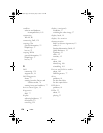
Glossary 173
travel module — A plastic device designed to fit inside the module bay of a portable
computer to reduce the weight of the computer.
U
UMA — unified memory allocation — System memory dynamically allocated to
video.
UPS — uninterruptible power supply — A backup power source used when the
electrical power fails or drops to an unacceptable voltage level. A UPS keeps a
computer running for a limited amount of time when there is no electrical power. UPS
systems typically provide surge suppression and may also provide voltage regulation.
Small UPS systems provide battery power for a few minutes to enable you to shut
down your computer.
USB — universal serial bus — A hardware interface for a low-speed device such as a
USB-compatible keyboard, mouse, joystick, scanner, set of speakers, printer,
broadband devices (DSL and cable modems), imaging devices, or storage devices.
Devices are plugged directly in to a 4-pin socket on your computer or in to a multi-port
hub that plugs in to your computer. USB devices can be connected and disconnected
while the computer is turned on, and they can also be daisy-chained together.
UTP — unshielded twisted pair — Describes a type of cable used in most telephone
networks and some computer networks. Pairs of unshielded wires are twisted to protect
against electromagnetic interference, rather than relying on a metal sheath around
each pair of wires to protect against interference.
UXGA — ultra extended graphics array — A video standard for video cards and
controllers that supports resolutions up to 1600 x 1200.
V
video controller — The circuitry on a video card or on the system board (in computers
with an integrated video controller) that provides the video capabilities—in
combination with the monitor—for your computer.
video memory — Memory that consists of memory chips dedicated to video functions.
Video memory is usually faster than system memory. The amount of video memory
installed primarily influences the number of colors that a program can display.
video mode — A mode that describes how text and graphics are displayed on a
monitor. Graphics-based software, such as Windows operating systems, displays in
video modes that can be defined as x horizontal pixels by y vertical pixels by z colors.
Character-based software, such as text editors, displays in video modes that can be
defined as x columns by y rows of characters.
book.book Page 173 Tuesday, July 3, 2007 12:31 PM


















